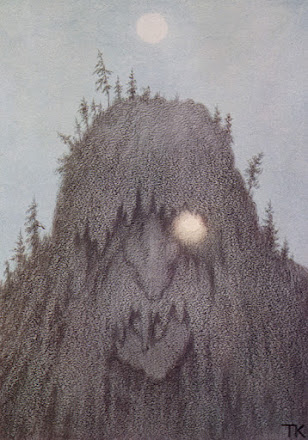In this post I'll begin the process of creating a specific creature for The Wyrd Land's bestiary. I've explained my design principles for these in this post. But to put it simply, this is going to be a creature that is of the world. It has to be truly magical, meaningful and complex. It also won't have any stats.
After picking up John Lindow's book Trolls in a fantastic book shop near where I live in the UK, I have decided to make these strange enigmas my focus. In this post I am going to write up the key things I took from the notes I made.
The trolls described by Lindow come from the 10th Century onward in Norway and Scandinavia. These early trolls are not the thuggish brutes that have come to us from Tolkien. Though these exist in the medieval literature, such as in the characters of Sledge-hammer and Iron-nose, inhabitants of Slab-land (likely Baffin Island in North America):
There he saw a big cave and a bright fire in it. He goes up to the cave door and sees that two trolls are sitting by the fire, one female, the other male, and the cookpot was between them. In it was the meat of both horses and men. The man had a hook in his nose and the woman a ring.
 |
| Forest Troll |
She speaks from the dusk and labels herself:
'seeress's friendly companion, guardian of the
corpse-fjord, swallower of heaven wheel;
what is a troll other than that?'
She is undoubtedly a monster: something of the wild, something not human and even dangerous. The comment about being 'swallower of heaven wheel' refers to Fenrir, who at Ragnorak will swallow the sun/moon.
They are undoubtedly creatures of death and magic (largely synonymous terms). There are several phrases such as 'May the trolls take you' meaning something like 'I hope you die'.
But there is something very vague in this. In many ways the term seems almost synonymous with "monster". There has to be something more to this.
For me, this comes in Lindow's opening story. A friend of his in the 1970s saw a troll while waiting for a train at night. It waved at them from a tree, holding them fixed in its gaze until the train arrived and it disappeared in the light.
It is something half-seen, half-heard but which has the ability to enchant. A much later religious piece of ethnography describes trolls that live in the mines; and we see them as creations of confused senses:
As and when [the trolls] please they show themselves to the miners as shadowy shapes in all possible forms; with the sound of voices they counterfeit laughter and senseless roars of merriment
Shapes in the flickering candles of the mine, voices echoing from the shuddering dark.
 |
| A mine troll (1555) |
They are not immaterial thought, because they can enchant. This enchanting was originally a verb: 'trylla'. Typically translated as enchant, Lindow prefers the term 'entrolled'. One is entrolled by the troll; the troll changes what it sees.
A story is given of a cow that licked the ashes of a troll-human, the cow then gave birth to a huge and mighty troll-bull. Other times humans are changed by something in life or in their birth and they become larger, more vicious; a witch changes herself into a leather bag of water, beaten despite her disguise, we are told: 'the troll's ribs are swollen.'
This comes to a head in my imagination, in a medieval Norse law. When a woman has been entrolled she needs character witnesses to say she is well or she must leave the district. But she can keep her property 'because she her self is not the cause of her being a troll.' To become a troll is something that is done to people.
Lindow talks about humans who commit foul deeds and become trolls. In Beowulf and Basilisks similar points are made about monsters in general: humans can become monsters when they cross the boundary of the hall and humanity.
.jpg) |
| The Sea Troll |
Taking this as a core concept I will bring out my design principles and try to create something practical and useful for those running adventures in the Wyrd Lands. Hope to see you there for it!


Comments
Post a Comment